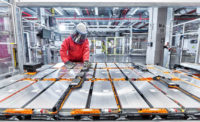GOLDEN, CO—The National Renewable Energy Laboratory (NREL) and NAATBatt International have created an updated supply chain database to identify all companies in North America associated with lithium-ion batteries. It includes firms involved in everything from mining to manufacturing to recycling.
"In response to industry requests, we have made this release of the database more intuitive, with easy-to-find information about companies involved in any aspect of the supply chain," says Vicky Putsche, P.E., a process engineer at NREL "We've even added an online version of the North American map to show a visual representation of where these companies are located."
"We [also] added filters to find companies working in different parts of the supply chain, allowing industry to identify competitors and collaborators, and to help policymakers understand the current state of the U.S.,” explains Putsche.
The NREL-developed-and-managed Lithium-Ion Battery Supply Chain Database showcases key areas for coordination between supply chain companies, such as linking end-of-life facilities with midstream manufacturing capabilities.
"This database is an important step in better understanding the lithium-ion battery market and its North American players," claims Ahmad Pesaran, Ph.D., NREL’s chief energy storage engineer. "The new online interface makes it even easier for companies in the supply chain and individual companies to find and connect with other players in this space, ultimately strengthening our supply chain security."
The database offers a directory of nearly 700 companies and 850 facilities in North America across lithium-ion battery supply chain segments. It also includes important information on each facility, such as location, workforce, and type of products and services provided.
In addition, the database summarizes key data such as installed battery manufacturing capacity and material production capability, plans for future capacity, types of chemistries and processes, and expansion plans by segment.
According to Pesaran, the number of facilities in the North American lithium-ion battery supply chain has doubled in less than three years. This increase has been the most notable for raw material manufacturing facilities, which jumped from only about 25 to more than 80.
"We're proud that we've been able to strengthen the database's offerings to provide a more comprehensive picture of the supply chain landscape in lithium-ion battery material processing, manufacturing and recycling," says Pesaran. "We have received a lot of compliments on the value and usefulness of the database."




